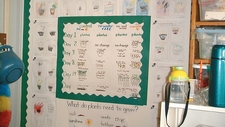Scientific Presentations

TEKS Objective
The student is expected to communicate valid conclusions supported by data in writing, by drawing pictures, and through verbal discussion.
Essential Understanding
The student uses scientific inquiry methods during laboratory and outdoor investigations.
Science Background
Teaching the Science Process Skills: Longwood University (PDF) – This article explains that students have to communicate clearly and effectively if they are going to share their observations with the class.
Teaching the Science Process Skills
Longwood University, www.longwood.edu
Creating and Exhibiting a Display: Holt, Rinehart, and Winston (PDF) – This section of a science fair guide provides tips for students presenting scientific data on a display board.
Creating and Exhibiting a Display
Holt, Rinehart, and Winston, Think Central, go.hrw.com
Signature Lesson
Swing and Sway: Young Scientist Challenge (PDF) –An open ended project that challenges students to address the problem of creating a structure resistant to wind. This activity was a prompt for a past online contest but the activity is still valid and engaging. Students presented their results with a video submission, which could still be done as an in-class activity.
Swing and Sway
Young Scientist Challenge, www.youngscientistchallenge.com
- Supporting Lessons
- Extensions
- Assessment Ideas
- Literature Connections
- Related
TEKS - Additional Resources
Supporting Lessons
Break the Tension, A Water Experiment: Education.com (website) - Students experiment with surface tension in water, and then communicate their conclusions verbally and in writing.
Break the Tension, A Water Experiment
by Alicia Danyali, Education.com
Elaboration Lessons and Extensions
How to Deliver a Good Oral Presentation: Discovery Education (website) - Tips for students (and their teachers) to overcome the natural apprehension of public speaking and deliver strong oral presentations.
How to Deliver a Good Oral Presentation
Discovery Education, school.discoveryeducation.com
Assessment Ideas
Evaluation Rubric for Science Presentations: Tempe Union High School District (website) - Use this rubric to score students’ oral, written or poster presentations.
Evaluation Rubric for Science Presentations
Tempe Union High School District, staff.tuhsd.k12.az.us
Oral Presentation Rubric: rubistar (website) - Complete rubric including 8 categories at 4 levels.
Oral Presentation Rubric
rubistar, www.rubistar.4teachers.org
Literature Connections
A+Projects: Winning Experiments for Science Fair. Vancleave, Janice (ISBN-13: 978-0471331025)
What’s the Plan? Designing Your Experiment. Hyde, Natalie (ISBN-13: 978-0778751540)
Additional Resources
Communication and Leadership: BioEd Online (videos) - View three videos, by expert Tracy Volz, PhD, to strengthen presentation and professional relations skills.
Enhancing Your Leadership Presence
BioEd Online, www.bioedonline.org
Dynamite PPT Design
BioEd Online, www.bioedonline.org
Planning and Preparing for a Leadership Presentation
BioEd Online, www.bioedonline.org
Science Notebooks in K12 Classrooms: Science Notebooks (website) - Examples of student work from science notebooks, guidance to incorporate science notebooks into your class activities, and strategies to integrate all content areas using notebooks.
Science Notebooks in K12 Classrooms
Science Notebooks, www.sciencenotebooks.org
TEKS Navigation
Grade 3
Need Assistance?
If you need help or have a question please use the links below to help resolve your problem.

Comments